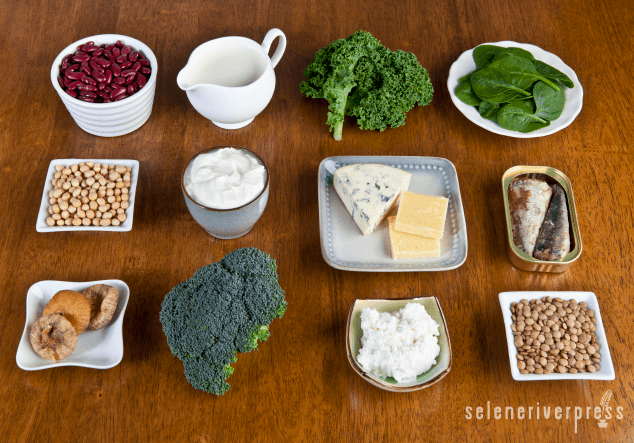Few supplements are taken as often—and used as improperly—as calcium. Dishonest peddlers have made millions of dollars by hyping this precious mineral. They give false hope to those who suffer from calcium deficiency, which creates a real dilemma for many holistic practitioners. In this short educational presentation, I’ll explain why.
I have to admit that even I—as a newly certified nutritionist—went along with the idea that calcium is calcium is calcium. I thought it important to recommend calcium supplementation and calcium-rich foods because our bodies vitally need it. Bone is a dynamic living tissue that’s constantly being broken down and rebuilt, so of course it requires the constant interplay of nutritional and hormonal factors to maintain its integrity.
As Dianne Onstad notes in The Mineral Companion (currently out of print), there are more than a quarter of a million different kinds of calcium. These can be divided into seven different classifications, six of which are essential to biological life: calcium oxide, calcium lactate, calcium phosphate, dolomite calcium, calcium carbonate, and tricalcium phosphate. Only one classification, pure calcium hydroxide, is fatal to biological life.
Providence smiled down on me when, in due time, I came to understand that not all calcium supplements are properly assimilated by the body. At one of the Standard Process seminars available to holistic practitioners, a presentation by Mark Anderson, Standard Process West Distributor, helped broaden my understanding of the various types of calcium. I learned that some calcium supplements can in fact create real havoc when they’re not absorbed by the GI tract. This information gave me the tools I needed to help both myself and others.
Like all natural things, calcium bicarbonate is the type most easily absorbed by the body. That’s why I personally use, and of course recommend, Standard Process Calcium Lactate. It’s as close as we can get to calcium bicarbonate. In fact, calcium lactate changes into calcium bicarbonate in just one step! With a 5 to 1 ratio, it’s highly absorbable form of calcium and magnesium. It’s also an easily ionized source of those same minerals. “Ionized” simply means to be wholly or partly converted into ions. John Courtney explains why this is good: “To ionize is to give an electrical charge to the item being ionized. The ionization of minerals makes them functional in our body, in the tissues.”
Other forms of calcium are far from beneficial. In fact, one of them has been so overhyped that it’s come under fire from the FDA for numerous false claims in advertising. It’s known as coral calcium, and I highly recommend that you study up on it before spending any money on this product.
Signs of Calcium Deficiency
- High blood serum calcium
- Muscle cramps
- Receding gums
- Kidney stones
- Tetany
- Mental symptoms (anxiety)
- Cravings, nail- or thumb-chewing, fevers
Calcium-Rich Foods
- Raw cheese
- Raw milk
- Yogurt, especially homemade
- Sardines (also the richest food source of RNA ribonucleic acid)
- Dark leafy greens such as spinach, kale, turnips, and collard greens
- Grains
In Nourishing Traditions, Sally Fallon Morrell recommends steaming or cooking spinach, kale, and collard greens prior to eating. And my Cook Your Way to Wellness DVD offers complete visual instruction on the proper preparation of grains. You can also learn all about the calcium content of various types of grains at this great resource.
“NT” Raw Buckwheat Groat Pancakes
For a delicious, calcium-rich breakfast, try this pancake recipe adapted from Chris Kesser. It includes a variation for the lactose intolerant—try making homemade yogurt and allowing it to ferment for at least 24 hours. This almost completely eliminates the lactose, which means you’ll likely be able to tolerate it.
Ingredients
- 1 cup raw buckwheat groats (not toasted)
- 2 cups yogurt (variation: homemade yogurt, fermented at least 24 hours)
- 2 soy-free eggs, beaten
- 1 teaspoon organic vanilla extract
- ½ cup milk, unsweetened almond milk, or water (optional)
- 1 teaspoon aluminum-free baking soda
- Pinch of salt
- Ghee, coconut oil, or lard
Instructions
Place buckwheat in a bowl, cover with yogurt, and soak for 12–24 hours at room temperature.
After soaking, rinse yogurt from buckwheat. Place buckwheat in a blender with approximately 1 cup of fresh yogurt (depending on how thick you like your pancakes). Blend until mixture is smooth. Rinse out the bowl that the buckwheat was soaked in. Add blended mixture back to the bowl.
Place a cast-iron pan or heavy ceramic pan (such as Le Creuset) over medium to medium-high heat while you mix the rest of the batter. The secret to cooking pancakes is to make sure the pan is hot before you add the batter.
Add eggs and vanilla. If using, add milk, almond milk, or water (omit this step if you like thicker pancakes). Mix wet ingredients together. Sprinkle baking soda and salt over the surface of the batter and mix thoroughly.
Add a generous amount of ghee, coconut oil, or lard to the hot pan. When fat is shimmering, ladle pancake batter onto the pan. Allow pancakes to cook almost all the way through before flipping. Add more fat between batches to make fritter-like pancakes. For more typical pancakes, skip this step.
Top with fruit, butter, kefir cream, whipped cream, coconut butter, or coconut milk. You can also add a small amount of honey if you don’t have blood sugar issues, but I find them sweet enough with fruit alone.
Photo from iStock/tamsindove



